|
Testing For War
General
Motors Milford Proving Ground in
World War Two
Milford, MI
1924-Current
This page updated on
4-22-2021.
The GM Proving Grounds at
Milford, MI, or more commonly known simply as "Milford" to those that
work within in General Motors, was used extensively by U.S. Army
Ordnance during World War Two. It acted as an auxiliary test
ground to the military's main proving ground at Aberdeen, MD.
Within the 1,000 acres and 19.652 miles of test track and roads, Milford
tested over 900 military vehicles from all manufacturers to make sure
they would perform in combat as needed during the Second World War.
Milford also had environmental chambers to test vehicles under extreme
temperature conditions. For
this work, it received the Army-Navy "E" award five times.

How cool is this? An M36 Jackson tank
destroyer is nearing the crest of the 25% grade gravel hill as a T26E1
starts up the grade. Image added 1-6-2021.

This map shows the layout of the General
Motors Milford Proving Grounds during the Second World War. The
layout has changed significantly since the end of the war. There
is now 4,000 acres and 130 miles of roads and test track at the facility.
Image added 1-6-2021.
|
Summary of Road Types and
Mileages from the 1944 Map |
|
Miles |
Types of Road |
|
0.095 |
Concrete Pavement |
|
4.539 |
Surface Treated Concrete |
|
1.258 |
Black Top |
|
0.175 |
Brick |
|
1.495 |
Gravel |
|
7.560 |
Unimproved Road |
|
4.530 |
Cross Country |
|
11.890 |
Total from map |
|
19.652 |
Actual Total |
Author's Note:
The map gives a total mileage of 11.890 miles. I found these
numbers added up to 19.652 miles.

The GM Proving Ground won the first Army-Navy "E" Award
on December 19, 1942. The letter below dated February 24, 1945
notified Milford that it had won its fourth star.

In this letter dated February 24, 1945,
Robert P. Patterson, Under Secretary of War informs the employees of
the GM Proving Grounds they have just earned their fourth star.

The GM Proving Grounds not only received the
Army-Navy "E" Flag but also four stars on it.
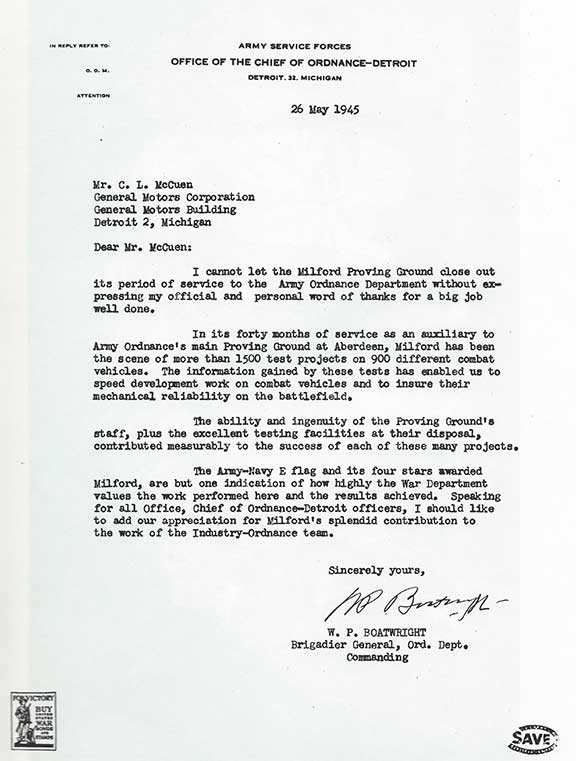
In this letter dated May 26,1945,
Brigadier General W.P. Boatwright of the Detroit Ordnance Department,
congratulates Milford Proving Ground on its four "E" star and specifies
the accomplishments of the Proving Ground to date. This included
1,500 test projects on 900 combat vehicles.

The main gate during World War Two.
Equipment tested at the GM Proving Grounds:
The GM Proving Ground was assigned over 1,500 projects on 900 different vehicles
between early 1942 and the end of the war. This was an average of
20 different vehicles tested each month.
A large majority of the armored vehicles and
trucks were built by the American Automobile Industry. Production
of these vehicles was very close to Milford.
|
Number of
military vehicles built by the American Automobile Industry
during World War Two |
|
Company |
Location |
Trucks |
Amphibious Trucks |
Tanks |
Tank Destroyers |
Armored Cars |
Self Propelled Artillery |
Other Vehicles |
Total |
| Buick |
Flint, MI |
|
|
|
2,507 |
|
|
640 |
3,147 |
|
Cadillac |
Detroit, MI |
|
|
8,592 |
|
|
1,778 |
300 |
10,670 |
|
Chevrolet |
Flint, MI and others |
281,570 |
|
|
|
3,844 |
|
|
285,414 |
|
Chrysler |
Warren, MI |
|
|
22,202 |
|
|
|
|
22,202 |
| Dodge |
Detroit, MI |
404,817 |
|
|
|
|
|
|
404,817 |
|
Fisher Body |
Grand
Blanc, MI |
|
|
13,139 |
5,855 |
|
|
40 |
19,034 |
| Ford |
Detroit, MI Area and others |
430,716 |
12,782 |
1,690 |
1,038 |
12,451 |
|
13,893 |
472,570 |
| GMC |
Pontiac, MI |
549,906 |
21,147 |
|
|
30 |
|
|
571,083 |
|
Studebaker |
South
Bend, IN |
194,535 |
|
|
|
|
|
24,924 |
219,459 |
|
Willys-Overland |
Toledo, OH |
350,349 |
|
|
|
|
|
|
350,349 |
|
Totals |
|
2,211,839 |
33,939 |
45,623 |
9,400 |
16,325 |
1,778 |
39,797 |
2,358,745 |
The 2.3 million vehicles produced by the
American auto makers during World War Two consisted of eight major types
of vehicles. They ranged in size from the 1/4 ton 4x4 command car (Jeep) up to the 46 ton M26 Pershing tank. With the exception of
Studebaker in South Bend, IN and Willys-Overland in Toledo, OH, all of
the vehicles were produced in southeast Michigan. Vehicles
designated for testing at the GM Proving Grounds by U.S. Army Ordnance
did not have very far to travel.
All vehicles and armament used by the
U.S. Army during World War Two were tested at the Aberdeen Proving
grounds in Maryland. How did Milford fit into the test program?
With 19.7 miles of roads and test tracks it could do road and endurance tests on the
different types of roads and terrain. The same type of
peacetime tests Milford performed on General Motors vehicles translated
directly into tests for military vehicles.
Chrysler leased the Packard Proving
Grounds during World War Two and Ford had its own proving ground in
Dearborn, MI. U.S. Army Ordnance directed many vehicles to be
tested at their respective company's proving grounds. However,
Army Ordnance directed many non-General Motors-built vehicles to be
tested at Milford tested during the war, as it specialized in tracked vehicles.
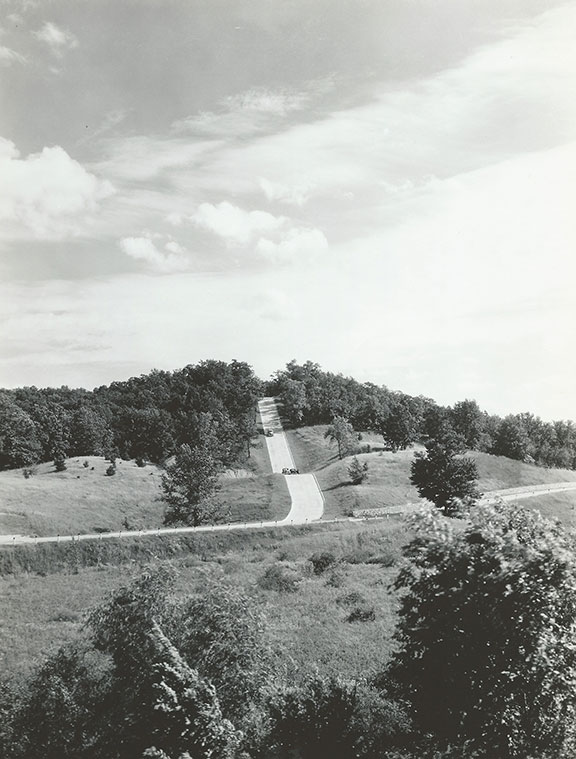
The GM Proving Grounds had this 25% concrete grade for testing both the
climbing and braking ability of military vehicles.

The original 1,000 acres was picked for its location
with rolling hills and flat open spaces. This provided an
excellent location for proper testing
of military vehicles.

Coming up the 25% Gravel Hill, which was part
of the durability course, is a M26
"Pershing" heavy tank. This 46-ton heavy tank may well
have been the heaviest vehicle tested at Milford. Both Fisher Body Division of GM
and Chrysler built the M26. However, this is most likely a Fisher
Body Grand Blanc-built M26. Fisher Body was the initial producer
of the Pershing and there was a rush program to get it into combat in
Europe.

Test item 8256 is a M1A1 Sherman tank
getting a cold soak. The same tests the Proving Ground did on
civilian automobiles carried over to the military vehicles. Tests
like this made sure the vehicle could start and operate in cold
climates. The European winter of 1944-45 was one of the coldest in
recent history. The Battle of the Bulge was fought during these
cold conditions and the American military vehicles had to operate in
this hostile environment. Image added 1-6-2021.

Here are a few of the 900 vehicles Milford
tested during World War Two. Five of are fully tracked tanks
and one is a half-track. There are also armored cars and a
half-track shown.
The vehicle on the far right, of which just a
small portion can be seen, is an M5 tank produced by Cadillac and
Massy-Harris. To its left is test vehicle 8202 which is a
Chrysler-built M4A4. It can be identified by the wider than normal
spacing between the bogies. The next are two small hatch M4 series
Sherman tanks. These could have been built by any of the eleven
companies that produced this tank. These companies included the
Fisher Body Division of GM,
the Ford Motor Company, and
the Chrysler Corporation. The next Sherman in line is a small
hatch M4A1. These were not built by the American Automobile
Industry. These were manufactured by Pressed Steel, Pacific Car
and Foundry, and Lima Locomotive Works. The next two
vehicles are Chevrolet-built "Staghound" armored cars built for British Commonwealth
Forces. Next is a Ford-built M20 armored car. The last vehicle
is a half-track. These were built by the White Motor Company,
Diamond T Motor Car Company, Autocar, and the International Harvester
Corporation.
Below are contemporary photos of the vehicles
shown in the photo above. These have been restored and are owned
by museums or private owners.

M5A1 Serial Number 6297 was built by Cadillac in April 1944. Unlike the
photo, this does not have the sand shields around the upper track.
These were easily damaged and removed from the tanks once in combat
zones. Author's photo added 1-6-2021.
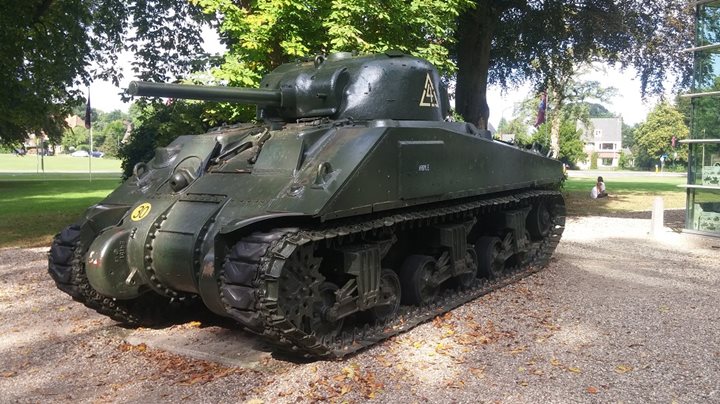
The next vehicle in line in the photo above
is a Chrysler-built M4A4 . Milford had several of these in for
testing during the war. In December, 1942 test vehicle number 8138
was at the Proving Ground. The example shown here is on display at the Arnhem War
Museum, Schaarsbergen
Netherlands. Photo courtesy of David Jackson, Jr. added 1-6-2021.
Another type of Sherman tank that was tested
at Milford was the prototype of the M4A6, which was powered by a
Caterpillar-built nine cylinder, all fuel radial aircraft engine.
This was at the Proving Grounds in June 1943. Only 75 of these
were built.

Starting in 1942, Pressed Steel Car Company,
located in the Chicago, IL area, had a number of its tanks at Milford
for testing during World War Two . This Pressed Steel-built small
hatch M4A1(75) is serial number 192, built in July 1942. It is USA
number 3014948. It is the oldest Pressed Steel M4A1(75) known to exist
and is owned by the Virginia Military Museum of Military Vehicles. Note
that this tank has the direct vision ports for the driver and assistant
driver. Author's photo added 1-6-2021.

Chevrolet built 2,844 T17E1 Staghound
armored cars for the British Commonwealth during World War Two.
Author's photo added 1-6-2021.

Ford built the M8 armored car during World War Two. In August1942
an M8 was at the GM Proving Ground for testing. Author's photo
added 1-6-2021.

Ford also built the M20 command car on the
same chassis as the M8. In March 1945 an M20 was at the GM Proving
Ground for testing. Author's photo added 1-6-2021.

Starting in mid-1942, International Harvester
half-tracks, built in Springfield, OH, were tested at Milford.
Author's photo added 1-6-2021.

A White-built M16 half-track with an M45
Quadmount gun turret was undergoing testing at Milford in August 1943.
Author's photo added 4-22-2021.
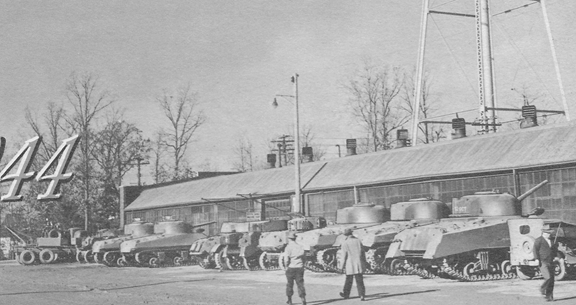
This 1944 photo contains five Sherman tanks,
a jeep, three M5 Stuart light tanks, and a T17E1 Staghound armored car.
An M1 10-ton 6x6 heavy wrecker is at the the far end. These were
built by both Ward-LaFrance and Kenworth. It is unknown whether
the wrecker was on-site for testing or to retrieve vehicles if they
broke down on a test track. Image added 1-6-2021.

This is a Ward-LaFrance M1 wrecker. A
GMC CCKW-353 is off to the right in this photo. Author's photo
added 1-6-2021.

The GM Proving Grounds tested a considerable
number of Sherman tanks. There are six in this photo of the
parking lot. One is either backing out or returning to its parking
place. Another is entering the lot after testing. There is
also a M24 Chaffee light tank, a half-track, and a GMC CCKW in this
photo. Image added 1-6-2021.
Below are more contemporary photos of vehicles
tested at the GM Milford Proving Grounds. Also included are
historical photos of many of the types of vehicles being tested.
Each show a different test. It should be noted that vehicles
coming to the Proving Grounds were put through a battery of tests shown
in the historical photos below.
Trucks: The Proving Grounds
tested a considerable number of Chevrolet and GMC trucks. The
jeep, built by both Ford and Willys-Overland, was also tested at
Milford.
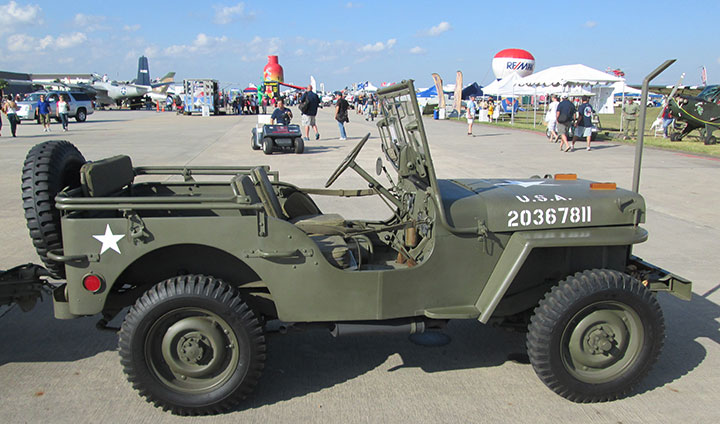
This jeep was built by Willys-Overland.
Author's photo added 1-6-2021.

Chevrolet built 1-1/2 ton 4x4 trucks that
came to Milford for testing. Author's photo added 1-6-2021.

A number of the Chevrolet 4x4s were used as
crash trucks at military air bases. Author's photo added 1-6-2021.

The GMC 2-1/2 ton 6x6 truck was used
extensively by tactical and quartermaster units in World War Two.
Author's photo added 1-6-2021.

This GMC CCKW-352 has a water depth
indicator attached to the front of the vehicle. Image added
1-6-2021.

This CCKW is starting up the 24% grade at
the Proving Grounds. Image added 1-6-2021.

GMC also built the DUKW which was the
amphibious version of the 2-1/2 ton 6x6 truck. Author's photo
added 1-6-2021.

A GMC DUKW entering Lake Sloan for a water
test. Image added 1-6-2021.

The DUKW was purposely stopped half-way up
the 60% incline. The parking brake was then set to verify it would
hold the vehicle in place. Then the DUKW proceeded to the top of
the hill. Image added 1-6-2021.
Tanks: There were 45,623 tanks
built by Cadillac, Chrysler, Fisher Body, and Ford in southeast
Michigan. The Sherman tanks were constantly undergoing engineering
changes and improvements as the war progressed. Many of the
modifications were then tested at Milford.

Chrysler built the M3 medium tank in nearby
Warren, MI. Early World War Two tanks were riveted together.
This was replaced in later models with welded designs. The auto
industry had to develop the technology to weld thick pieces of armor
plate. Author's photo added 1-6-2021.

This shows a riveted M3 Lee tank negotiating
up an incline. Of special interest is a woman GM technician
assisting the driver of the vehicle. She was a leader in the quest
for women to do technical jobs. Image added 1-6-2021.

An M3 tank is entering the 100-foot water test. The M3 tanks were
some of the first World War Two vehicles to be tested at Milford, as it
was already in production with several manufacturers. It was
superseded in 1942 by the M4 Sherman tank. Image added
1-6-2021.

American Car and Foundry of Berwick, PA
built all of the M3 and M3A1 light tanks during World War Two. A
late model M3 light tank was at Milford in July 1942. It was a
late model M3 and very similar to this M3A1. Author's photo added
4-22-2021.

The Cadillac-built M8 75mm Gun Motor
Carriage was built on the M5 chassis. These had to undergo the
same testing at the M5. Author's photo added 1-6-2021.

Ford built M4A3 Sherman tanks at its former
Model T plant in Highland, MI. Holes can be seen along the bottom
edge of the hull above the tracks. These were for the attachment
of sand shields. Author's photo added 1-6-2021.

This mud test actually worked too well when
the bottom of the mud hole collapsed and this Fisher Body-built M4A2
became stuck. It had to be towed out by another vehicle.
Tanks operated off-road and when it rained, they operated in mud.
Tests like this showed the problems that operating in this type of
environment presented. As the war progressed, tracks on Sherman
tanks were widened to provide less ground pressure to operate on soft or
muddy terrain. Tests like this help to predict the effectiveness
of the proposed changes. Image added 1-6-2021.
Note that
the Ford M4A3 has its sand shields attached.

This is a Fisher Body Grand Blank-built
M4A2(75)VVSS. Milford tested a number of these. Note the
narrow track on this. Author's photo added 1-6-2021.
This Sherman tank is on display at in Victoria
Park in London, Ontario. It is the oldest Grand Blanc-built
Sherman tank in existence in the western hemisphere and is the third
oldest worldwide of all of the tanks built by Fisher Body Division of
General Motors. It is a true war veteran and is the only tank that
survived the war in operation with the 6th Canadian Armored Regiment
(1st Hussars). Due to its historical significance, I wonder why the
authorities and historians in Canada have not moved this to an indoor
venue to keep it out of the elements. It is such a shame this grand old
tank that fought all the way from D-Day to VE Day has to sit outside.

This Fisher Body Grand Blanc, MI built
M4A2(76) HVSS is a later model of the Sherman tank with wider tracks. It can be seen outside the Beatty
Street Drill Hall in Vancouver, BC. It was one of 7,508 M4A2s
built by Fisher Body. Photo courtesy of David Jackson, Jr.

The 100 foot water test was available for
testing military vehicles such as this Fisher Body-built M4A2(76) HVSS.
Image added 1-6-2021.

A Chrysler-built M4(105) was at Milford for
testing in December 1944. It was test number 8705. Author's
photo added 1-6-2021.

Cadillac and Massey-Harris both built the
Cadillac designed M24 Chaffee light tank which were tested at Milford.
Author's photo added 1-6-2021.

The hilly and rocky terrain allowed for
testing the M24's ability to negotiate this rough climb.
Image added 1-6-2021.
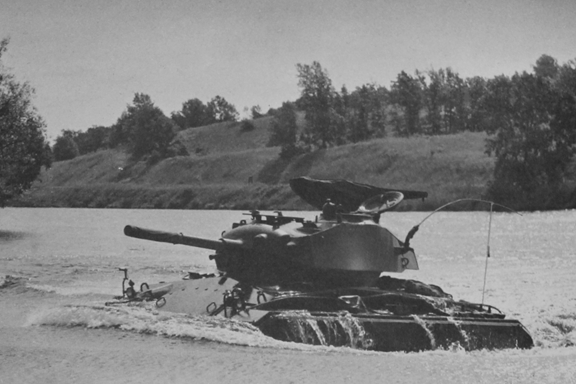
Lake Sloan was utilized to test military
vehicles for their fording ability. Here a Cadillac M24 is fording
four feet of water. Early in World War Two there was a severe
problem with tanks failing when entering deep water. This resulted
in re-designs to include the waterproofing of many electrical
components. Later tanks like the M24 incorporated all the lessons
learned from early war experience and tests at Milford.
Image added 1-6-2021.

Fisher Body was first into production on the
M26 heavy tank. Only Fisher Body-built M26 saw combat during World
War Two. Author's photo added 1-6-2021.
Tank Destroyers: Buick, Fisher
Body, and Ford were the only producers of fully tracked tank destroyers
in World War Two. These vehicles were similar to tanks but were
faster because they carried less armor. Milford was a prime
location to test them.

This Fisher Body-built M10 tank destroyer
was built in April 1943. It was virtually identical to the
Ford-built M10A1 with the exception of the engine. The Fisher Body
M10 was powered by two Detroit Diesel engines while the Ford M10A1 was
powered by a Ford gasoline engine. Author's photo added 1-6-2021.

This M10 is undergoing a drawbar test by
pulling six weighted General Motors trucks. Image added
1-6-2021.

Buick built the M18 tank destroyer in Flint,
MI. Author's photo added 1-6-2021.

An M18 is negotiating the obstacle climb
test at Milford. This is one test that was installed for tracked
vehicles, with no counterpart for civilian automobiles or trucks. Image added 1-6-2021.

In this test, the M18 is undergoing a
high-speed endurance test. The M18 was the fastest fully tracked
armored vehicle built during World War Two. It had a top speed of
55 miles an hour. However, at speeds this fast took a toll on the
equipment, which would become evident on the high speed track.
Image added 1-6-2021.

This was one of 300 M36 tank destroyers that
Fisher Body Grand Blanc built during World War Two. Author's photo
added 1-6-2021.
Armored Cars:

Chevrolet was the only producer of the
Staghound armored car. Author's photo added 1-6-2021.

The Staghound is undergoing an off-road
test. Image added 1-6-2021.

This Chevrolet-built T17E1 Armored Car
was photographed at the Milford Proving Grounds on June 10, 1943.
It was test vehicle number 8263.


This GMC- built T18E2 Boarhound was
photographed Milford on January 19, 1943. During the first
half of World War Two GMC was known as the Yellow Truck Company, as it
states on the information board.
Personal Carriers:

Studebaker was the designer and builder of
the M29 series Weasel. Author's photo added 1-6-2021.
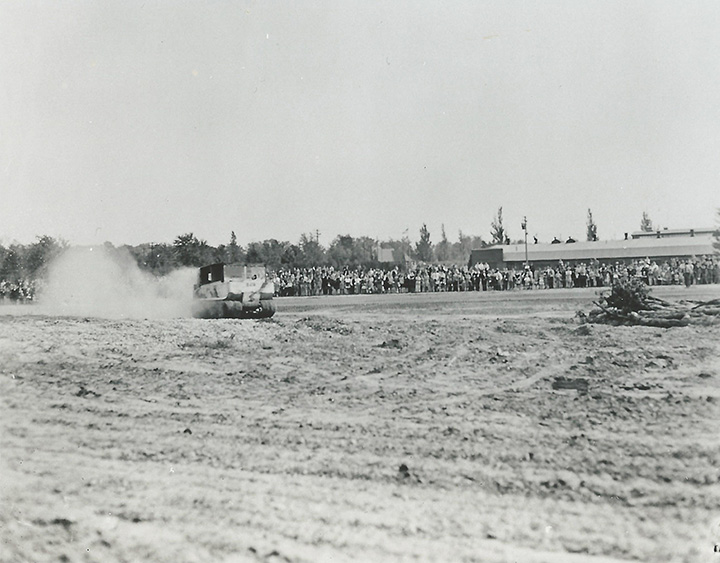
This Studebaker Weasel demonstrated its
capabilities during an employees' family open house.
Weapons: Ten General Motors
Divisions built weapons during World War Two. AC Spark Plug,
Delco-Products, and Brown-Lipe-Chapin built .50 caliber machine guns;
Fisher Body built 90mm and 120mm anti-aircraft guns; Oldsmobile built
several types of tank guns and aircraft cannons; Pontiac built 20mm
anti-aircraft guns; Inland built .30 caliber M1 carbines; Guide-Lamp
built .45 caliber sub-machine guns; Saginaw Steering Gear built .30
caliber machine guns and .30 caliber M1 carbines. Some of these
weapons were brought to the Proving Grounds for testing.

This is an example of a Pontiac-built 20mm
Oerlikon anti-aircraft cannon. This type weapon was tested at
Milford. Author's photo added 1-6-2021.

Sand is being blown onto the 20mm Oerlikon
during a test firing to verify it will continue to operate under these
conditions. This appears to be a staged photo, as the weapon does
not appear to be firing. Typical of the era, neither lab
technician is wearing safety glasses nor hearing protection.
Image added 1-6-2021.

In the back of the display case at the
Museum of the United States Air Force in Dayton, OH is an Oldsmobile M2
aircraft cannon. This one of 77,010 the division built in
World War Two. Author's photo added 1-6-2021.

This Oldsmobile 20mm aircraft cannon is
being tested to verify it is synchronized properly to fire through the
arc of an aircraft propeller. The paper disk is attached to an
electric motor and spins to simulate an aircraft propeller. When
the gun fires, the projectiles should go through the holes in the disk
that represent the space between the propeller blades. It is
unknown for what aircraft this was being tested. There are no
known American aircraft that had a 20mm cannon firing through the
propeller arc. Image added 1-6-2021.

Guide-Lamp Division of Anderson, IN brought
its M3 submachine gun to Milford for testing. Author's photo added
1-6-2021.
|
































































